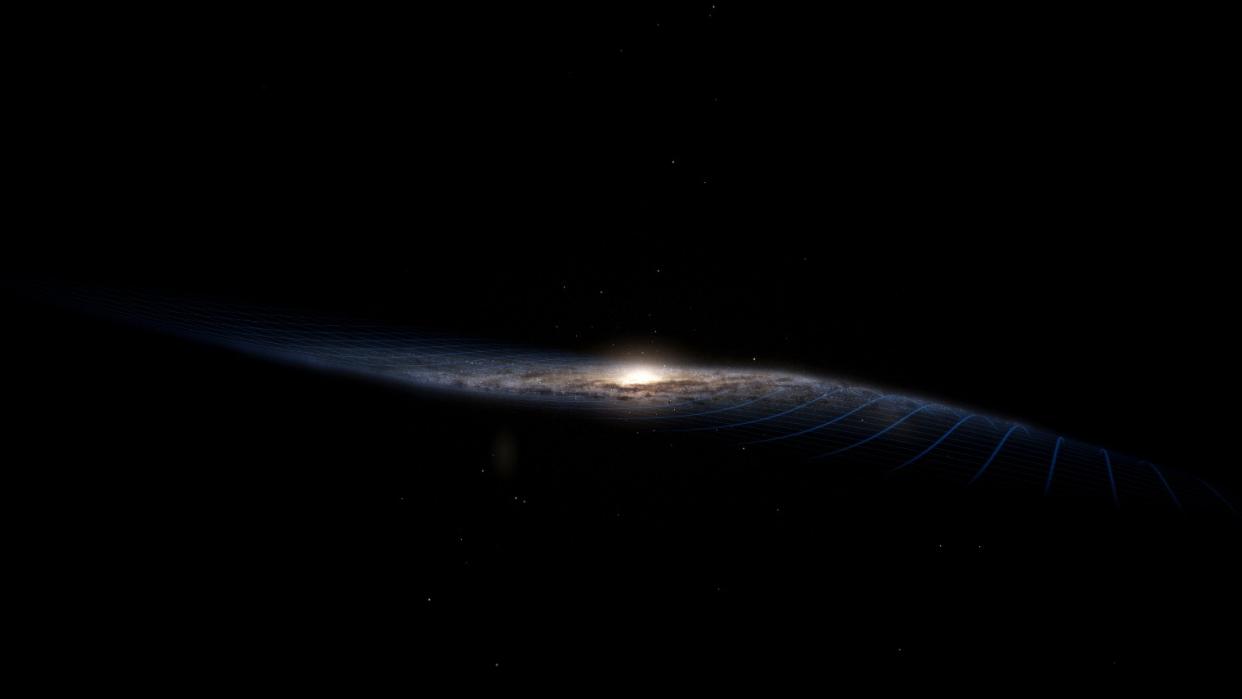Our entire galaxy is warping, and a gigantic blob of dark matter could be to blame

A gigantic blob of invisible dark matter has bent our galaxy out of shape, a new study suggests.
Scientists initially believed that the Milky Way was a flat disk dominated by two spiral arms trailing stars from a central bar, but measurements taken since the mid-20th century reveal that it's bent inexplicably out of shape.
The warping occurs mostly at our galaxy's borders, where some regions bend downward while others flare upward — giving it the look of a crushed sombrero. Now, computer simulations may have revealed the cause: a mysterious event that knocked our galaxy's invisible halo of dark matter out of alignment. The scientists published their findings Sept. 14 in the journal Nature Astronomy.
Related: Dark matter could be building up inside dead stars — with potentially explosive consequences
"These results, in combination with data in the stellar halo, provide compelling evidence that our Galaxy is embedded in a tilted dark matter halo," the researchers wrote in the study.
Dark matter is a mysterious and somewhat contradictory type of matter. It makes up 85% of the universe's matter; but because it doesn't directly interact with light, it is completely invisible.
However, scientists can observe its gravitational effects on its surroundings. Dark matter makes its presence known by accelerating stars to otherwise inexplicable speeds as they orbit galactic centers; warping distant starlight; and by giving shape to the Milky Way's galactic halo.
The galactic halo — a vast sphere of stars floating like leaves on a dark matter pond — rests just beyond the spiral arms of the Milky Way. In a 2022 study, astronomers investigated this region using the European Space Agency's Gaia spacecraft, which maps the positions and movements of the Milky Way's roughly 2 billion stars. By poring through Gaia's data, they discovered that the stars suspended in the galactic halo were strangely off-kilter.
related stories
—Euclid space telescope: The groundbreaking mission to study dark matter and energy
—Dark matter's secret identity could be hiding in distorted 'Einstein rings'
To see what an unbalanced stellar halo might mean for the dark matter halo it is suspended in, the researchers used a computer model to recreate a young Milky Way-like galaxy with a dark matter halo tilted 25 degrees with respect to its disk. After simulating the galaxy over 5 billion years, the researchers found that they had created a very similar galaxy to our own.
"Here we show that a dark halo tilted in the same direction as the stellar halo can induce a warp and flare in the Galactic disk at the same amplitude and orientation as the data," the researchers wrote.
What caused the dark matter around our galaxy to fall out of tilt isn't clear, but the researchers' simulations suggest it is likely to have been a gigantic collision, likely from another galaxy flying into our own. This collision could have caused the dark matter halo to tilt up by as much as 50 degrees before slowly swinging down to its current 20-degree angle elevation.
Solve the daily Crossword

